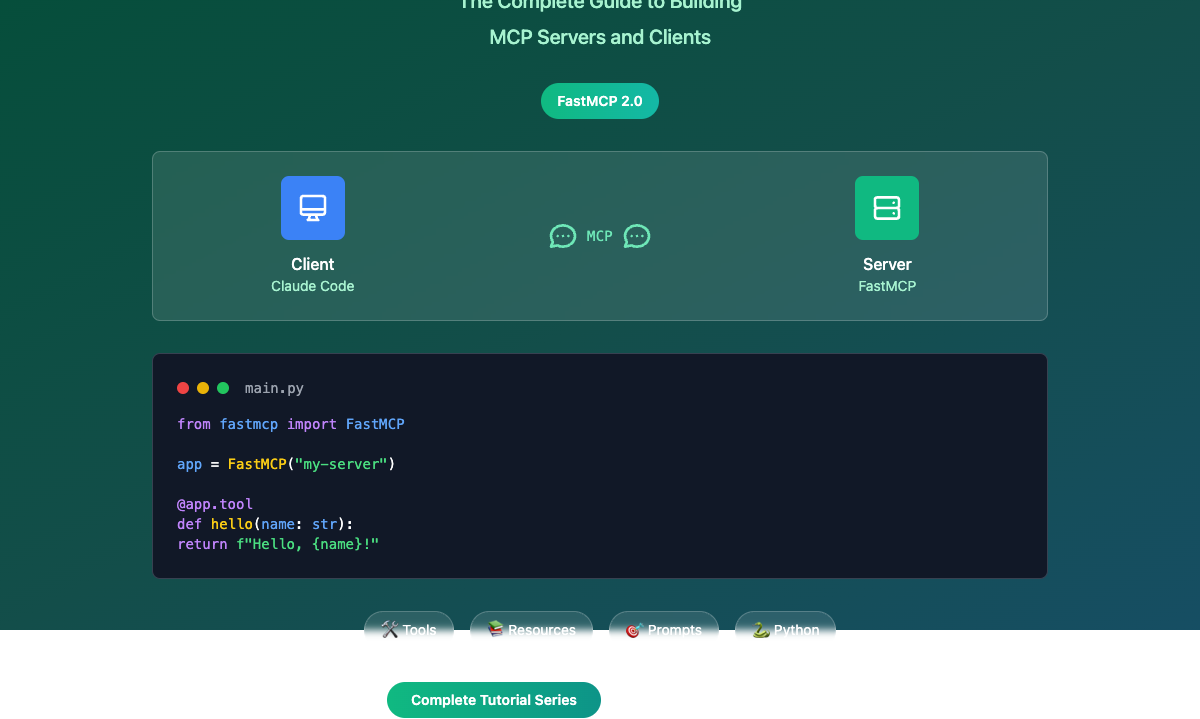课 3
2025-07-03 06:58
打造强大的工具与资源
构建强大的工具与资源
理解 MCP 组件
FastMCP 服务器向 LLM 客户端公开三种主要的组件类型:
- 工具(Tools):执行操作或计算的函数。
- 资源(Resources):客户端可读取的数据源。
- 提示(Prompts):用于 LLM 交互的可复用消息模板。
接下来,我们将探讨如何有效地构建每种组件。
创建工具
工具是 MCP 服务器的强大核心。它们使 LLM 能够执行操作、进行计算、调用 API 并与外部系统交互。
基本工具
最简单的工具是使用装饰器修饰的函数:
from fastmcp import FastMCP
mcp = FastMCP("Utility Server")
@mcp.tool
def calculate_area(length: float, width: float) -> float:
"""计算矩形面积。"""
return length * width
@mcp.tool
def generate_password(length: int = 12, include_symbols: bool = True) -> str:
"""生成随机密码。"""
import random
import string
chars = string.ascii_letters + string.digits
if include_symbols:
chars += "!@#$%^&*"
return ''.join(random.choice(chars) for _ in range(length))
带上下文的高级工具
工具可以访问 MCP 上下文以执行高级操作:
from fastmcp import FastMCP, Context
import aiohttp
import json
mcp = FastMCP("API Tools")
@mcp.tool
async def fetch_weather(city: str, ctx: Context) -> dict:
"""获取指定城市当前天气。"""
await ctx.info(f"正在获取 {city} 的天气信息...")
# 使用上下文进行 HTTP 请求
response = await ctx.http_request(
"GET",
f"https://api.openweathermap.org/data/2.5/weather",
params={"q": city, "appid": "your_api_key"}
)
weather_data = response.json()
return {
"city": city,
"temperature": weather_data["main"]["temp"],
"description": weather_data["weather"][0]["description"],
"humidity": weather_data["main"]["humidity"]
}
@mcp.tool
async def analyze_text(text: str, ctx: Context) -> str:
"""使用客户端的 LLM 分析文本。"""
prompt = f"""
请分析以下文本并提供以下方面的见解:
1. 情感
2. 关键主题
3. 写作风格
文本: {text}
"""
# 使用客户端的 LLM 进行分析
response = await ctx.sample(prompt)
return response.text
具有复杂返回类型的工具
工具可以返回各种数据类型,包括媒体:
from fastmcp import FastMCP
from fastmcp.types import Image, BlobResourceContents
import matplotlib.pyplot as plt
import io
import base64
mcp = FastMCP("Data Visualization")
@mcp.tool
def create_chart(data: list[float], chart_type: str = "line") -> Image:
"""根据数据创建图表。"""
plt.figure(figsize=(10, 6))
if chart_type == "line":
plt.plot(data)
elif chart_type == "bar":
plt.bar(range(len(data)), data)
plt.title(f"{chart_type.title()} Chart")
plt.xlabel("Index")
plt.ylabel("Value")
# 保存为字节流
buffer = io.BytesIO()
plt.savefig(buffer, format='png')
buffer.seek(0)
# 转换为 base64
image_base64 = base64.b64encode(buffer.read()).decode()
return Image(
data=image_base64,
mimeType="image/png"
)
@mcp.tool
def process_data(numbers: list[float]) -> dict:
"""处理数字列表并返回统计信息。"""
import statistics
if not numbers:
return {"error": "未提供数据"}
return {
"count": len(numbers),
"sum": sum(numbers),
"mean": statistics.mean(numbers),
"median": statistics.median(numbers),
"std_dev": statistics.stdev(numbers) if len(numbers) > 1 else 0,
"min": min(numbers),
"max": max(numbers)
}
构建资源
资源公开了 LLM 可以读取并融入其上下文的数据。它们非常适合配置数据、文档或任何只读信息。
静态资源
具有固定 URI 的简单数据源:
@mcp.resource("config://database")
def get_database_config() -> dict:
"""数据库配置设置。"""
return {
"host": "localhost",
"port": 5432,
"database": "myapp",
"ssl_enabled": True
}
@mcp.resource("docs://api-guide")
def get_api_documentation() -> str:
"""API 使用文档。"""
return """
# API 使用指南
## 认证
所有请求均需在 Authorization 头部中提供 API 密钥。
## 速率限制
- 基础版:每小时 1000 次请求
- 高级版:每小时 10000 次请求
## 可用端点
- GET /users - 列出所有用户
- POST /users - 创建新用户
- GET /users/{id} - 获取用户详情
"""
动态资源模板
模板允许客户端使用参数请求特定数据:
@mcp.resource("users://{user_id}/profile")
def get_user_profile(user_id: int) -> dict:
"""获取用户档案信息。"""
# 在真实应用中,这里会查询数据库
users_db = {
1: {"name": "Alice Johnson", "role": "Admin", "email": "[email protected]"},
2: {"name": "Bob Smith", "role": "User", "email": "[email protected]"},
3: {"name": "Carol Davis", "role": "Manager", "email": "[email protected]"}
}
user = users_db.get(user_id)
if not user:
raise ValueError(f"未找到用户 {user_id}")
return {
"id": user_id,
**user,
"last_login": "2024-01-15T10:30:00Z",
"status": "active"
}
@mcp.resource("data://{dataset}/stats")
def get_dataset_stats(dataset: str) -> dict:
"""获取特定数据集的统计信息。"""
# 模拟不同的数据集
datasets = {
"sales": {"records": 10000, "last_updated": "2024-01-15", "size_mb": 45.2},
"users": {"records": 5000, "last_updated": "2024-01-14", "size_mb": 12.8},
"products": {"records": 2500, "last_updated": "2024-01-13", "size_mb": 8.1}
}
if dataset not in datasets:
raise ValueError(f"未找到数据集 '{dataset}'")
return {
"dataset": dataset,
**datasets[dataset],
"access_level": "public"
}
基于文件的资源
资源也可以提供文件内容:
import os
from pathlib import Path
@mcp.resource("files://{file_path}")
def read_file_content(file_path: str) -> str:
"""读取项目目录中的文件内容。"""
# 安全措施:限制在项目目录内
project_root = Path(__file__).parent
full_path = project_root / file_path
# 确保路径在项目目录内
if not str(full_path.resolve()).startswith(str(project_root.resolve())):
raise ValueError("访问被拒绝:路径超出项目目录")
if not full_path.exists():
raise FileNotFoundError(f"文件未找到: {file_path}")
return full_path.read_text(encoding='utf-8')
@mcp.resource("logs://{date}")
def get_daily_logs(date: str) -> str:
"""获取特定日期的应用程序日志。"""
import datetime
try:
# 验证日期格式
datetime.datetime.strptime(date, "%Y-%m-%d")
except ValueError:
raise ValueError("日期格式必须为 YYYY-MM-DD")
log_file = f"logs/{date}.log"
if not os.path.exists(log_file):
return f"在 {date} 未找到日志"
with open(log_file, 'r') as f:
return f.read()
创建提示
提示为 LLM 交互提供了可复用的模板:
@mcp.prompt
def code_review_prompt(code: str, language: str = "python") -> str:
"""生成用于代码审查的提示。"""
return f"""
请审查以下 {language} 代码并提供以下方面的反馈:
1. 代码质量和可读性
2. 性能考量
3. 安全顾虑
4. 最佳实践遵循情况
5. 改进建议
代码:
```{language}
{code}
```
请提供建设性反馈,并给出具体示例。
"""
@mcp.prompt
def data_analysis_prompt(data_description: str, questions: list[str]) -> str:
"""生成用于数据分析的提示。"""
questions_text = "\\n".join(f"- {q}" for q in questions)
return f"""
我需要帮助分析具有以下特征的数据:
{data_description}
我希望探索的具体问题:
{questions_text}
请提供结构化的分析方法,并建议
适当的统计方法或可视化方式。
"""
错误处理与验证
健壮的工具应包含适当的错误处理:
@mcp.tool
def divide_numbers(a: float, b: float) -> float:
"""除以两个数字,并进行错误处理。"""
if b == 0:
raise ValueError("不能除以零")
if not isinstance(a, (int, float)) or not isinstance(b, (int, float)):
raise TypeError("两个参数都必须是数字类型")
return a / b
@mcp.tool
def process_email(email: str) -> dict:
"""验证并处理电子邮件地址。"""
import re
# 基础电子邮件验证
email_pattern = r'^[a-zA-Z0-9._%+-]+@[a-zA-Z0-9.-]+\\.[a-zA-Z]{2,}$'
if not re.match(email_pattern, email):
raise ValueError("电子邮件格式无效")
username, domain = email.split('@')
return {
"email": email,
"username": username,
"domain": domain,
"is_valid": True
}
测试组件
始终测试你的工具和资源:
import asyncio
from fastmcp import Client
async def test_server():
async with Client(mcp) as client:
# 测试工具
result = await client.call_tool("calculate_area", {"length": 5, "width": 3})
print(f"面积: {result.text}")
# 测试资源
config = await client.read_resource("config://database")
print(f"配置: {config.content}")
# 测试资源模板
user = await client.read_resource("users://1/profile")
print(f"用户: {user.content}")
if __name__ == "__main__":
asyncio.run(test_server())
最佳实践
- 清晰文档:始终包含描述性的文档字符串。
- 类型提示:使用适当的类型注解以自动生成模式。
- 错误处理:提供有意义的错误消息。
- 安全性:适当验证输入并限制文件访问。
- 性能:考虑将异步操作用于 I/O 密集型任务。
- 测试:彻底测试所有组件。
在下一节中,我们将探讨如何将 FastMCP 服务器与 Claude Code 集成,以实现无缝的开发工作流程。
